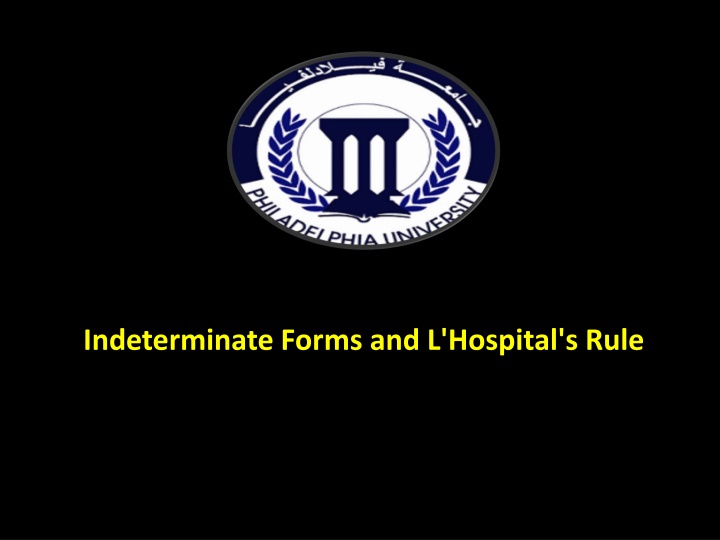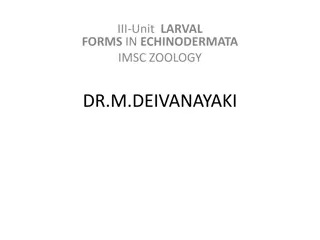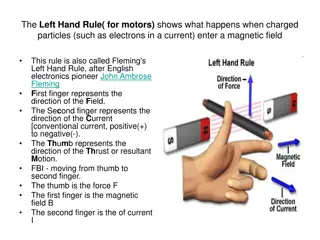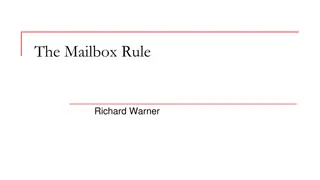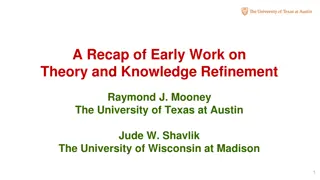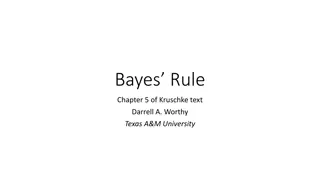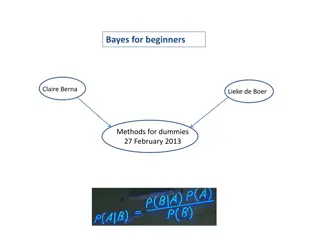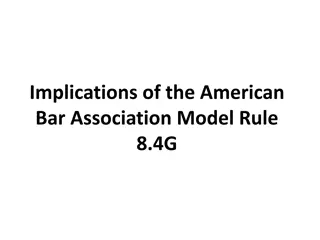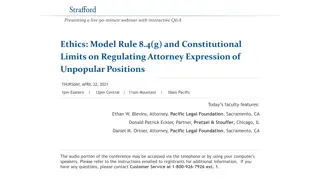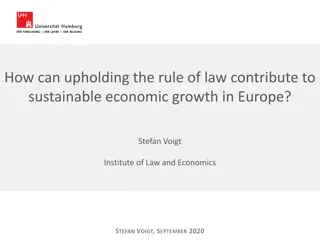Indeterminate Forms and L'Hopital's Rule
This chapter delves into the key applications of derivatives, showcasing how they are used to find extreme values, analyze graph shapes, calculate fractions limits, and numerically determine where functions equal zero. Learn about L'Hopital's Rule and various indeterminate forms along with detailed theorems and examples.
Download Presentation

Please find below an Image/Link to download the presentation.
The content on the website is provided AS IS for your information and personal use only. It may not be sold, licensed, or shared on other websites without obtaining consent from the author.If you encounter any issues during the download, it is possible that the publisher has removed the file from their server.
You are allowed to download the files provided on this website for personal or commercial use, subject to the condition that they are used lawfully. All files are the property of their respective owners.
The content on the website is provided AS IS for your information and personal use only. It may not be sold, licensed, or shared on other websites without obtaining consent from the author.
E N D
Presentation Transcript
This chapter studies some of the important applications of derivatives. We learn how derivatives are used to find extreme values of functions, to determine and analyze the shapes of graphs, to calculate limits of fractions whose numerators and denominators both approach zero or infinity, and to find numerically where a function equals zero.
James Stewart, Calculus: Early Transcendentals, 7th Edition, Brooks/ Cole 2012. Howard Anton, Irl C. Bivens and Stephen Davis, Calculus: Early Transcendentals, 9th Edition, John Wiley & Sons, Inc. 2010. Salas, Etgen, and Hille, Calculus: One and Several Variables, 10th Edition, John Wiley & Sons, Inc. 2007.
John Bernoulli discovered a rule for calculating limits of fractions whose numerators and denominators both approach zero or + . The rule is known today as L'Hospital's Rule. We will learn four types of indeterminate forms: 1. Indeterminate Form ?/? and / . 2. Indeterminate Products ? . 3. Indeterminate Differences . 4. Indeterminate Powers ??, ?and ? .
Type 1: Indeterminate Form ?/? and /: Theorem: Suppose ? and ? are differentiable and ? (?) ? on an open interval ? that contains ? (except possibly at ?). Suppose that ? ? ? ?=? lim ? ? then or ? ? ? ? ?= lim ? ? ? ? lim ? ? if the limit on the right side exists or . ? ?
L'Hospital's Rule says that the limit of a quotient of functions is equal to the limit of the quotient of their derivatives, provided that the given conditions are satisfied. It is especially important to verify the conditions regarding the limits of and before using L'Hospital's Rule. L'Hospital's Rule is also valid for one-sided limits and for limits at infinity or negative infinity.
ln ? ? ?. Example: Find lim ? ? ? ?ln? = ? and lim Solution: Since lim ? ?? ? = ?, then we can apply L'Hospital's Rule: ? ??(ln?) ? ??(? ?) ln? ? ?= lim ?/? ? ? ?= ? lim ? ? = lim ? ? = lim ? ? ? ? ?? ??. Example: Calculate lim ? ? ??= and lim ?? ??= lim ? ??= , so ? ??(??) ? ? ? Solution: We have lim ?? ?? L'Hospital's Rule gives: lim ??(??)= lim ? ? ?
Since ?? and ?? as ? , the limit on the right side is also indeterminate, but a second application of L'Hospital's Rule gives: ?? ??= lim ? Example: Calculate lim ? Solution: Since lim ? ln? = and lim , L'Hospital's Rule applies: ln? ??= lim ? ?? ??= lim ln ? ??. ?? ?= lim ? ? ?? = as ? ? ?/? lim ? ? ?? ?/?
Notice that the limit on the right side is now indeterminate of type ? L'Hospital's Rule a second time as we did in the previous example, we simplify the expression and see that a second application is unnecessary: ln? ??= lim ? ? ?. But instead of applying ?/? ?? ?/?= lim ? lim ? ??= ? ?
Type 2: Indeterminate Products ? : We can deal with it by writing the product as a quotient: ? ?/?or ?? = This converts the given limit into an indeterminate form of type ?/? or / so that we can use L'Hospital's Rule. ? ?? = ?/? Example: Evaluate lim Solution: The given limit is indeterminate because, as ? ?+, the first factor ? approaches ? while the second factor ln? approaches . ? ?+?ln?.
? ?/?we have ?/? as ? ?+, so Writing ? as L'Hospital's Rule gives: ln? ?/?= lim ?/? ?/??= lim lim ? ?+?ln? = lim ? ?+( ?) = ? ? ?+ ? ?+ Type 3: Indeterminate Differences : If lim ? ?? ? = and lim lim ? ?[? ? ? ? ] ? ?? ? = , then the limit is called an indeterminate form of type .
To find out the limit, we try to convert the difference into a quotient by using a common denominator, or rationalization, or factoring out a common factor so that we have an indeterminate form of type ?/? or / . Example: Evaluate lim ?) (sec? tan?). ? (? Solution: First notice that sec? and tan? as , so the limit is indeterminate. Here we use a common denominator:
cos?sin? ? lim ? (? ?) (sec? tan?) = ? sin ? cos ? lim ? (? cos? ?) cos ? sin ?= ? = lim ? (? = lim ? (? ?) ?) ? (???/? ?). Example: Calculate lim Solution: Notice that ???/? and ? as ? , so the limit is indeterminate. Here we use a common factor:
?(??1/2 ?) = lim ? ?(?1/2 ?) = 0 lim which is indeterminate form of type 2. Writing ? as 1/? we have 1/? 0 as ? , so L'Hospital's Rule gives: ? (??1/2 ?) = lim = lim ? 1/? 1 ?2?1/? 1 ?2 ? ?(?1/2 ?) lim ?1/? 1 ? ?1/?= 1 = lim ? = lim
Type 4: Indeterminate Powers ??, ?and ?: These several indeterminate forms arise from the limit lim ? ?? ? Each of these three cases can be treated by writing the function as an exponential: ? ? and then ?(?)= ?lim where the indeterminate product ?(?)ln?(?) is of type ? . ?(?) ?(?)= ??(?) ln ?(?) ? ??(?) ln ?(?) lim ? ?? ?
??+??. Example: Find lim Solution: Notice that this limit is indeterminate since ??= ? for any ? > ? but ??= ? for any We could proceed by writing the function as an exponential ??= ?? ln ?and then . lim ? 0+? ln ?= ??= ? ? ?+??= ? lim
